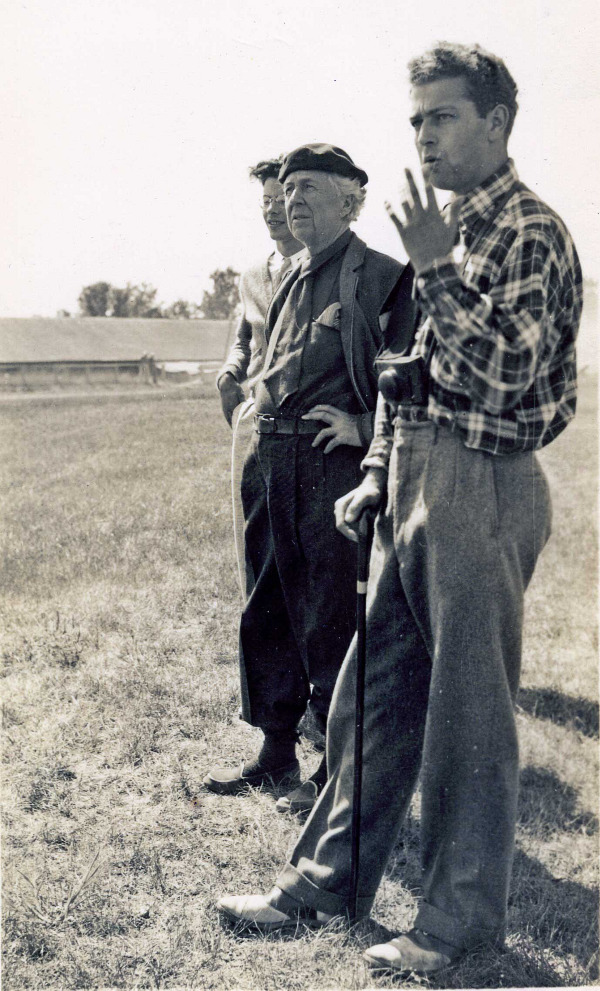In 2011, Ken Love received a Fitch Fellowship, in association with the Edgar Tafel Trust, to reproduce, restore, and preserve his original 1994 documentary film “Fallingwater: A Conversation with Edgar Kaufmann, Jr.” On August 4th, Mr. Love’s work was profiled on NPR’s “Morning Edition.” Read the full transcript below or click here to listen to the story.
Forget The 117 Steps: 3-D Video Makes Fallingwater Accessible To All
David Greene for NPR Morning Edition
——————————————————————————-
DAVID GREENE, HOST: Fallingwater is really an architectural masterpiece. The house in rural southwestern Pennsylvania is the work of Frank Lloyd Wright. People from all over the world come to visit it. The structure is built into a hillside. And the true marvel is how the house looks like it’s hovering in the air over a waterfall. But what makes Fallingwater so unique is exactly what makes it challenging for those who struggle with mobility. Erika Beras from member station WESA reports.

MEGHAN: I’d like to welcome all of you to Fallingwater. I’m Meghan (ph).
ERIKA BERAS, BYLINE: Ruth Bachman is touring the first floor of Fallingwater.
MEGHAN: The two small doors would open in.
BERAS: She admires the stone fireplace and built-in furniture while listening to the sound of the rushing waterfall. But that’s as far as Bachman gets. Her wheelchair prevents her from seeing the rest of the house. Frank Lloyd Wright called it organic architecture, a style that blends a building into the natural environment. The house has 117 steps. Most of the doorways are too narrow for wheelchairs. Fallingwater is a half-mile from the road. And not much can be done to modify it.
LYNDA WAGGONER: The building is the object.
BERAS: That’s Lynda Waggoner, director of Fallingwater.
WAGGONER: That’s why we’re there, is because of the architecture of the building. So there is no place to put an elevator in that building. There’s no way to deal with it.
BERAS: Which has left countless disabled visitors unable to tour the house – until now.
RUTH BACHMAN: Oh, my. Oh, my goodness. Look at that. That’s about the fifth wow.
BERAS: In the visitor center, Ruth Bachman watches a new, no-glasses, narrated 3-D video of Fallingwater. The images are rounder and deeper than on a regular screen. The tour takes her into the room she couldn’t access, lingers on one-of-a-kind architectural details and transports her through the rocky terrain that surrounds the property.
BACHMAN: I don’t think a video takes the place of actual being. I really think you have to visit the place. But if you can’t visit, I guess it’s better than not.
BERAS: The Fallingwater video was shot by filmmaker Ken Love. He says this new technology brings the house’s best features to life.
KEN LOVE: A lot of people question 3-D in terms of, what does it add to the storytelling? And for architecture, it adds a lot. It gives you this whole sense of scale and dimension.
BERAS: And it could be an asset for others, even if they aren’t disabled.
AMAYA: I want to see all around.
BERAS: Friends Mariko Franz and Kate Zaidan are here with Franz’s young daughters. Children have to be 6 to tour the house, which is full of original dishes and furnishings. So the group spent the morning walking the grounds. Now, over lunch, they’re watching the video.
UNIDENTIFIED WOMAN: We didn’t even see that.
AMAYA: It’s because we weren’t in there.
UNIDENTIFIED WOMAN: I know. We weren’t allowed.
AMAYA: Well, you guys were.
UNIDENTIFIED WOMAN: Well, yeah.
BERAS: It’s only in recent history that buildings have had to comply with disability laws. Brian Goeken, who works in preservation at the National Park Service, says honoring those requirements without compromising architecture is a challenge for historic homes such as Mount Vernon, Graceland and Fallingwater.
BRIAN GOEKEN: There should be full access for all Americans to be able to see and appreciate these properties. And we’re also trying to ensure that what they’re seeing is preserved and the historic characters of the property remains intact.
BERAS: 3-D tours could help fill that void. Filmmaker Ken Love plans on creating a similar video for Kentuck Knob, another Frank Lloyd Wright house, and hopes videos such as this become the norm at historic houses all over the country and maybe even the world. For NPR News, I’m Erika Beras.
